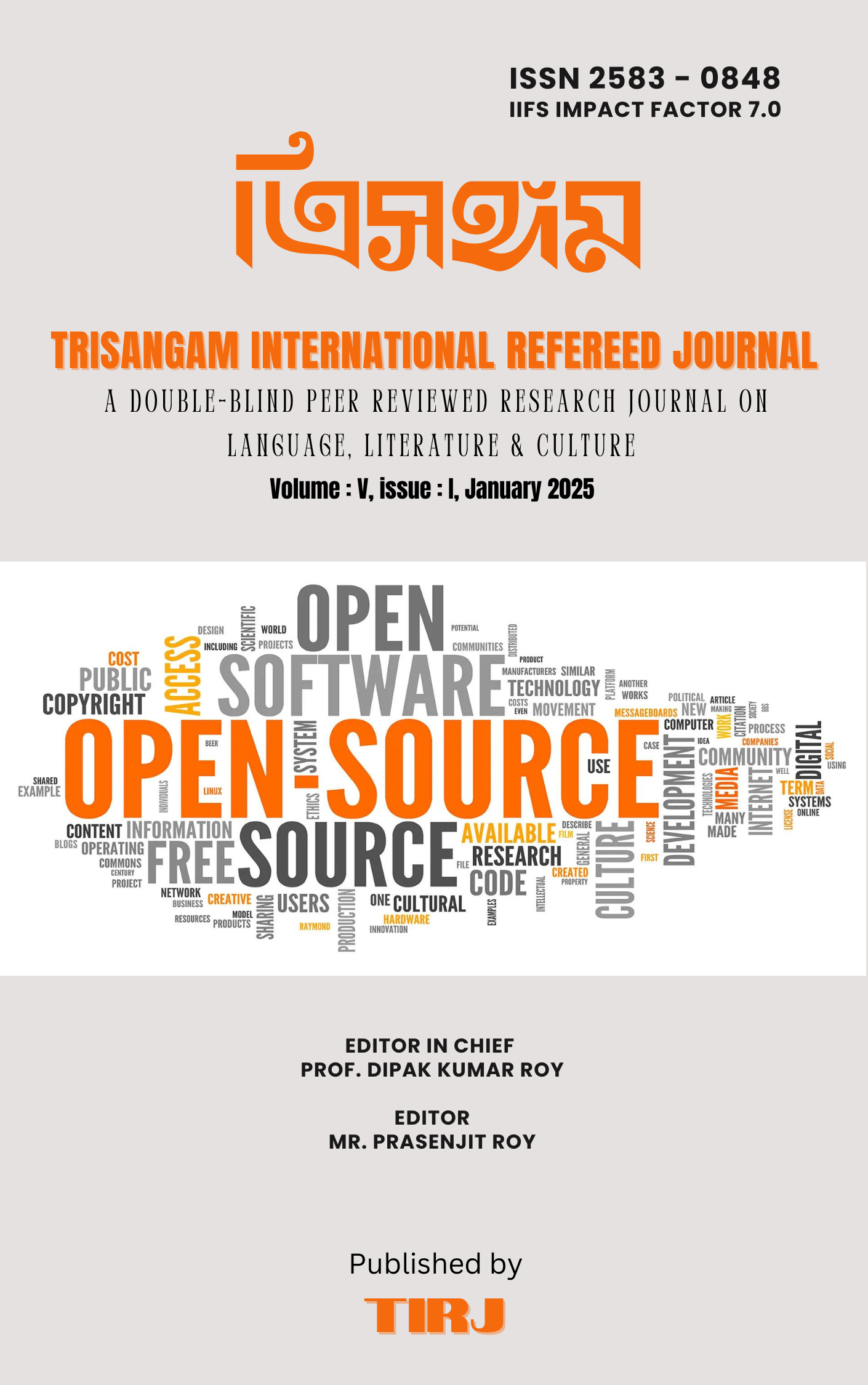Social Consciousness of Sarat Chandra chattopadhyay in the light of His Writings/ শরৎ সাহিত্যের আলোকে শরৎচন্দ্রের সমাজ-চেতনা
Keywords:
- Social evils,
- condition of women,
- lower class,
- patriarchal society,
- caste discrimination,
- superstition
Abstract
‘Literature can act as a mirror of society’. This is very much true about the writing of all great writers, Sarat Chandra chattopadhyay being one among them. The vast corpus of his writing- novels, short stories, essays- depicted superstition, social injustice and condition of women of his time. But behind all his writings was his silent intention to inform and educate his readers about evils of society as he saw it. Sarat Chandra Chattopadhyay was also a very socially conscious person and as a very popular writer, he did not write various stories, novels and essays only for the purpose of writing literature, but also from his firm belief that it was his moral duty for creating social consciousness against various social evils. He firmly believed that, one should try to remove various injustices and superstitions from society by writing against them. Sarat Chandra believed that the root of social evils and problems stem from socio-economic discrimination, the disturbing condition of lower caste and class, caste discrimination, the way women were treated in a patriarchal society, particularly in contemporary Hindu society. These social evils were so firmly rooted in the minds of people that it was impossible for people to get rid of these social evils and malpractices unless they were completely uprooted.
In the article under discussion, there will be an attempt to analyze how Sarat Chandra chattopadhyay, through his various novels, stories and articles, tried to form a public opinion among his readers by writing against various social evils and various social injustices. In short, the main aim of this research paper is to reveal how his social consciousness has been revealed through the Sarat Chandra's literature, that is, how much Sarat Chandra was a socially conscious person, in the light of the literature he created.
Downloads
References
১. দাশগুপ্ত, অশীন. ইতিহাস ও সাহিত্য, কলকাতা - 9, আনন্দ পাবলিশার্স লিমিটেড, প্রথম সংস্করণ জানুয়ারি ১৯৮৯, পৃ. ২৭
২. কুমার, শ্রী মদনমোহন. (সম্পা.), শরৎচন্দ্র, কলকাতা, বঙ্গীয় সাহিত্য পরিষৎ, ১৩৮৩ বঙ্গাব্দ, পৃ. ১৬৫. 2-রা আশ্বিন ১৩৩৯ বঙ্গাব্দে (ইংরাজি ১৯৩৩ সাল) কলকাতা টাউন হলে অনুষ্ঠিত প্রতিভাষণ।
৩. বসু, সুভাষচন্দ্র. ‘স্বদেশপ্রেমিক শরৎচন্দ্র’, দে, বিশ্বনাথ. (সম্পা.) শরৎস্মৃতি, কলকাতা ৭৩, সাহিত্যম, ১৩৭৭ বঙ্গাব্দ (১৯৭০ খ্রিঃ). পৃ. ৪৩
৪. 14-8-1919 তারিখে লীলারানী গঙ্গোপাধ্যায়কে লেখা শরৎচন্দ্রের চিঠি। দ্রষ্টব্য: রায়, গোপালচন্দ্র. শরৎচন্দ্র, কলকাতা, আনন্দ প্রকাশন, প্রথম আনন্দ সংস্করণ এপ্রিল ২০০৩, পৃ. ৭৬
৫. রায়, শ্রী গোপালচন্দ্র, শরৎচন্দ্র (প্রথম খণ্ড), কলকাতা- 12, সাহিত্যসদন, ১৩৬৯, পৃ. ৪৪০
৬. চট্টোপাধ্যায়, শরৎচন্দ্র, ‘শ্রীকান্ত’ (প্রথম পর্ব), অষ্টম পরিচ্ছদ, শরৎ রচনাবলী (প্রথম খণ্ড), কলকাতা, শুভম প্রকাশন, বইমেলা ২০১১, পৃ. ৪২২ - ৪২৩
৭. চট্টোপাধ্যায়, শরৎচন্দ্র. ‘সাহিত্যে আর্ট ও দুর্নীতি’, শরৎ রচনাবলী (দ্বিতীয় খণ্ড), পূর্বোক্ত, পৃ. ৯৩৭
৮. অধ্যাপক রণজিৎ গুহ ‘নিম্নবর্গ’ শব্দের ব্যাখ্যা প্রসঙ্গে বলেছেন - “...উচ্চবর্গ বলতে আমি বোঝাতে চাই তাদেরই, ইংরেজ শাসিত ভারতবর্ষে যারা প্রভুশক্তির অধিকারী ছিল। ...ঔপনিবেশিক ভারতে যারা এই সংজ্ঞা অনুযায়ী উচ্চবর্গের অন্তর্গত, সমগ্র জনসংখ্যা থেকে তাদের বাদ দিলে যা অবশিষ্ট থাকে তারাই নিম্নবর্গ। এর মধ্যে শহরের শ্রমিক ও গরিব, সর্বোচ্চ পদের আমলাদের বাদ দিয়ে মধ্যবিত্তের বাকি অংশ, গ্রামের ক্ষেত মজুর, গরিব চাষী ও প্রায় গরিব মাঝারি নিম্নবর্গের মধ্যে গণ্য। তাছাড়াও এই সংজ্ঞায় শুদ্ধ অর্থে গণ্য হবে নির্বিত্ত ভূস্বামী, অপেক্ষাকৃত হীনবল গ্রামভদ্র, অপেক্ষাকৃত সম্পন্ন মাঝারি কৃষক এবং ধনী কৃষকেরাও...” অর্থাৎ তাঁর বক্তব্য অনুযায়ী কৃষক, শ্রমিক, শহুরে জনতা, আদিবাসী, নিম্নবর্ণের মানুষ এমনকি মহিলারাও নিম্নবর্গের অন্তর্ভূক্ত। অপরদিকে বিদেশী শাসক, বণিক, পুঁজিপতি, দেশি অভিজাত, বুর্জোয়া ও উচ্চশ্রেণীর মানুষরা উচ্চবর্গের অন্তর্গত। সুতরাং নিম্নবর্গ কথাটি কেবলমাত্র বর্ণগত বা জাতিগত অর্থেই প্রযুক্ত নয়, পেশাগত, গুণগত এমনকি অর্থনৈতিক ভাবে পশ্চাদপদ শ্রেণী বোঝাতেও ব্যবহৃত হয়েছে।
দ্রষ্টব্যঃ গুহ, রণজিৎ. ‘নিম্নবর্গের রাজনীতি ও ইতিহাসবিদ্যার দায়িত্ব’, এক্ষণ ১৫-শ বর্ষ, তৃতীয় ও চতুর্থ সংখ্যা, পৃ. ১৪-১৭
৯. রায়, গোপালচন্দ্র. শরৎচন্দ্র, কলকাতা, আনন্দ প্রকাশন, আনন্দ পাবলিশার্স, কলকাতা, সেপ্টেম্বর ২০০৯, পৃ. ৮
১০. কুমার, শ্রীমদনমোহন. (সম্পা.), শরৎচন্দ্র, কলকাতা, বঙ্গীয় সাহিত্য পরিষৎ, ১৩৮৩ বঙ্গাব্দ, পৃ. ৭৮
১১. রায়চৌধুরী, অনির্বাণ. শরৎসাহিত্যে আধুনিকতা ও অন্যান্য প্রসঙ্গ, চারুপত্র প্রকাশনী, কলকাতা, পৃ. ৩৪
১২. রায়, গোপালচন্দ্র. শরৎচন্দ্র, কলকাতা, আনন্দ প্রকাশন, প্রথম আনন্দ সংস্করণ এপ্রিল ২০০৩, পৃ. ১৬৫
১৩. চট্টোপাধ্যায়, শরৎচন্দ্র. ‘শ্রীকান্ত’ (তৃতীয় পর্ব), শরৎ রচনাবলী (১ম খণ্ড), কলকাতা, শুভম প্রকাশন, বইমেলা ২০১১. পৃ. ৫
১৪. গুপ্ত, আনন্দগোপাল, ‘দলিত আন্দোলন প্রশ্ন ও প্রসঙ্গ’, সেন, সুজিত. (সম্পা.) ইতিহাসের প্রেক্ষিতে ভারতে দলিত আন্দোলন, গ্রন্থমিত্র, কোলকাতা, পৃ. ১৬৫
১৫. চট্টোপাধ্যায়, শরৎচন্দ্র, ‘তরুণের বিদ্রোহ’, শরৎ রচনাবলী (দ্বিতীয় খণ্ড), শুভম প্রকাশন, কোলকাতা, ২০১১, পৃ. ৮৯৮






